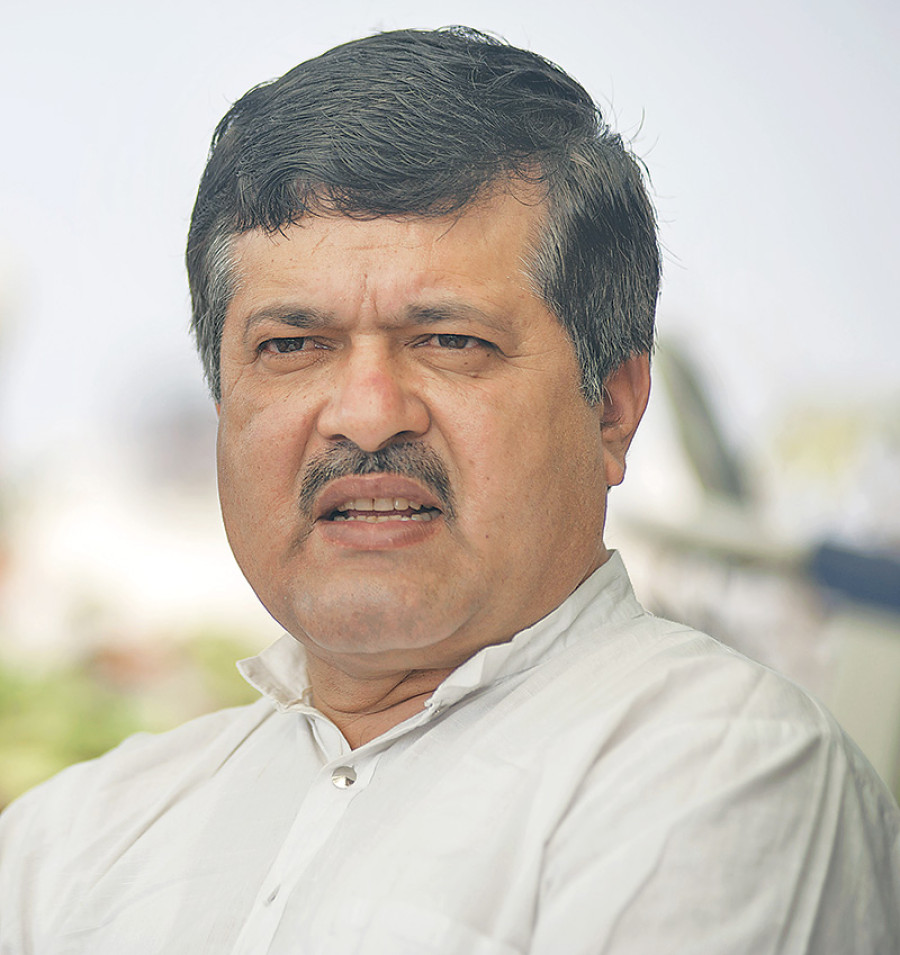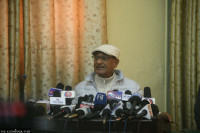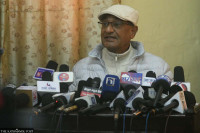National
Attorney general flounders as he defends Oli’s House dissolution move
Legal experts closely following the hearing say Agni Kharel focussed more on political than constitutional grounds to justify why prime minister was right to dissolve the House.
Binod Ghimire
After advocates pleading on behalf of the petitioners who have challenged Prime Minister KP Sharma Oli’s House dissolution move were done, starting Monday lawyers defending the government started their arguments before the Constitution Bench.
Attorney General Agni Kharel, as the chief counsel to the government, is leading the team of defending lawyers.
Kharel, however, floundered on both Monday and Tuesday, as he tried to justify Oli’s House dissolution decision. He failed to provide concrete constitutional grounds for doing so and instead continued to offer political reasons for the act.
In his arguments on Tuesday, the attorney general explained that House dissolution is a prime minister’s prerogative. He, however, stopped short of providing the constitutional provisions that vested Oli with power to dissolve the House.
Kharel also cited the same articles Oli has cited–76 (1), 76 (7) and 85–for dissolving the House and argued that Oli as a majority prime minister “can dissolve the House.”
When asked by justices, Kharel did not say which article of the constitution authorised Oli to dissolve the House.
He reiterated that the prime minister used his inherent power.
“Our constitution has adopted a parliamentary system as its key feature,” argued Kharel. “As Article 74 of the constitution says we have adopted parliamentary democracy, we must understand the prime minister has an authority to dissolve the House of Representatives."
Article 74 of the Constitution of Nepal says: “The form of government of Nepal shall be multi-party, competitive, federal, democratic, republican and parliamentary based on pluralism.”
Those opposing Oli’s move had argued that articles 76 (1) and 76 (7) cited by him are related to the formation of the government, which do not allow a majority prime minister to dissolve the House.
Kharel was one of the key members of the Constituent Assembly which drafted the constitution with the said provisions, making it difficult for a prime minister to dissolve Parliament given Nepal’s past experiences of political instability.
Both Subas Nembang, who oversaw the constitution drafting as the chair of the Constituent Assembly, and Kharel were in the past fierce proponents of writing strong provisions that would bar the prime minister from dissolving the House at the drop of a hat.
Ever since dissolving the House, Oli has been arguing that the dissolution was a political move which doesn’t warrant a judicial review.
But Kharel now is in a bind. In the capacity of attorney general, history has landed upon him the duty of defending a prime minister who faces charges of dissolving the House.
Kharel hence has been providing the same reason that Oli has offered—that the cause of the House dissolution was political.
During the hearing on Monday and Tuesday, Kharel was faced with a barrage of questions from justices, who sought the constitutional ground for dissolving the House.
Kharel, however, could not provide concrete answers.
Bipin Adhikari, former dean at Kathmandu University School of Law, who has been following the ongoing hearing closely, said the attorney general must present enabling provisions in the constitution for the House dissolution.
“But he has failed to do so,” Adhikari told the Post. “It is not that Kharel doesn’t know. It is because there is no constitutional provision that he can present before the court to establish that Oli’s move is valid.”
Those who have been supporting Oli’s move often cite past House dissolutions by different prime ministers.
On Tuesday, Kharel too tried to present Girija Prasad Koirala’s example to justify Oil’s move.
Koirala in 1994 had dissolved the lower house despite leading a majority government. The Supreme Court had then upheld Koirala’s decision.
But as soon as Kharel cited Koirala’s move, Justice Anil Kumar Sinha intervened, asking how the 1994 incident was relevant now as the country has already adopted a new constitution which has entirely different provisions.
Koirala had employed Article 53 (4) of the Constitution of the Kingdom of Nepal 1990 to dissolve the House in 1994. That constitution had a clear provision that “the King shall dissolve the House of Representatives on the recommendation of the prime minister”.
Three other House dissolution attempts were made under the 1990 constitution by different prime ministers after Koirala in 1994.
Manmohan Adhikari and Surya Bahadur Thapa, who led minority governments, had also recommended House dissolutions, in 1995 and 1998, respectively, but the Supreme Court had overturned their decisions.
In 2002, Sher Bahadur Deuba too dissolved the House. It was upheld by the court.
Experts say the new constitution does envision House dissolution, but its drafters deliberately made it a complicated process so as to ensure stability. Article 76 (7) of the 2015 constitution envisions dissolution only when there is a hung parliament with no possibility to form a government, according to them.
“It is natural for Kharel to put political cause as he doesn’t have any constitutional grounds to back his arguments,” said Adhikari. “The Supreme Court takes the decision based on constitutional grounds, not on political grounds.”
In a long-winded letter, which came into the public domain some days ago, recommending the President that the House be dissolved, Oli has also said that obstacles created in governance by a section of leaders in his party had necessitated the House dissolution. He has also argued that a two-thirds majority government was required for stability hence he wanted to seek a fresh mandate of the people.
During the hearing, Kharel was intervened by justices on different occasions when he made political arguments instead of sticking to logical and constitutional reasonings.
In an attempt to justify Oli’s move, Kharel said that Nepal has adopted the Westminster system of governance.
He even claimed that the June 2015 16-point agreement between the Nepali Congress, then CPN-UML, then CPN (Maoist Centre) and Madhes-based parties was about the forms of governance, which talked about parliamentary democracy.
Justice Sapana Pradhan Malla intervened, asking how the agreement between the parties can even be taken as legislative intent.
Kharel was at a loss for words.
Experts say Kharel’s premise that Nepal has adopted a parliamentary democracy to justify House dissolution as the prime minister’s prerogative is outright wrong. According to them, Nepal does not follow the Westminster model in its entirety, as it has adopted various practices from different countries.
“Our system is a defective child of the Westminster system. Though its genesis is Westminster, it has gone through several modifications,” Shree Krishna Aniruddha Gautam, a political analyst who writes for the Post’s sister paper Kantipur, told the Post.
“When the constitution clearly provides conditions for House dissolution, he cannot say it's the prime minister’s prerogative.”
Kharel would be right, in principle, if Nepal had a constitution clearly mentioning that the prime minister possesses inherent power to dissolve the House. Since Nepal is a country with a written constitution, the executive has to follow it to the letter and spirit, according to experts.
Ram Krishna Timilsena, former registrar at the Supreme Court and executive director at National Law College, said that Nepal has a modified parliamentary system.
Timilsena said Nepal has borrowed some provisions from German and French models as well, even though the system it follows appears to be modelled on India and the United Kingdom. While India has a written constitution, the United Kingdom does not.
“We have adopted a completely different model through modifications in the parliamentary system,” Timilsena told the Post. “Now whatever arguments Kharel is presenting, he is doing it as his duty to defend the government.”
Senior advocate Sushil Pant, who argued on behalf of the government, also defended the House dissolution move saying that in the Westminster system, the prime minister has two inherent powers: to sack the ministers and dissolve the House.
“The court shouldn’t just focus on the letters of the constitution,” said Pant. “It should also look at practices and specialties of the governance system.”
Adhkari, the former dean at Kathmandu University School of Law, said that in his observation, the defending lawyers were standing on a very weak premise while making a case for the House dissolution.
“It seems other defendants won’t have any new arguments to present,” said Adhikari. “As we saw repetition when lawyers argued against the House dissolution, it seems we will have the same.”
According to Adhikari, the bench must intervene when the same arguments are repeated to ensure an early verdict.
An early verdict on the matter is expected to remove political uncertainties the country faces. If the court overturns Oli’s House dissolution move, Nepal’s politics will once again return to Parliament; if not, the country has to go for the polls. As per the government schedule, the first phase of voting takes place on April 30, and it’s just 87 days away.
“The longer the court takes to reach a verdict,” said Adhikari, “the more complications there could be.”




 7.12°C Kathmandu
7.12°C Kathmandu













%20(1).jpg&w=300&height=200)

